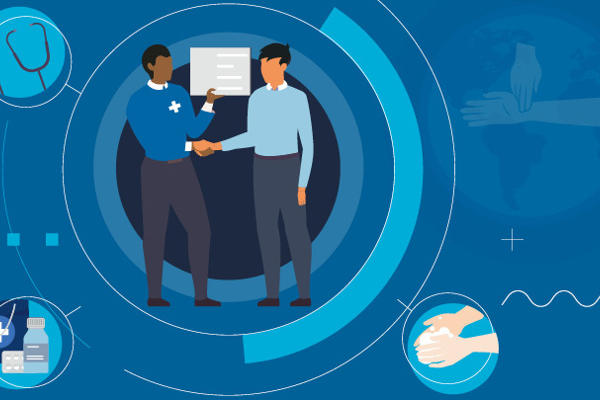The National Audit of Falls and Bone Health in Older People reports that there is unacceptable variation in the quality of NHS services for care and prevention of falls and fractures. In many areas, there is a major gap between what NHS organisations claim to provide, in terms of commissioning, protocols or structure; and what clinical audit reveals in terms of actual care provided. The audit shows that older patients with fractures do not routinely receive key aspects of care for falls prevention or bone health, needlessly exposing them to a greater risk of further falls and fractures.
The audit was commissioned by the Healthcare Quality Improvement Partnership (HQIP) and carried out by the Royal College of Physicians’ Clinical Effectiveness and Evaluation Unit (CEEU) as part of the National Clinical Audit and Patient Outcomes Programme (NCAPOP). Information on nearly 10,000 patients came from all NHS Acute Trusts, or equivalent, in England, Wales and Northern Ireland, as well as Primary Care Organisations, Mental Health Trusts and a sample of care homes.
These findings are significant given the scale of the problem: Every year, over 500,000 older people attend UK Emergency Departments following a fall and 200,000 suffer fractures due to osteoporosis. Falls and fractures in the over-65s account for over 4 million bed days per year in England alone, at an estimated cost of £2 billion. Falls and fractures often lead to disability and loss of independence, and are the leading cause of accidental death in this age group. Well-organised services, based on evidence-based national standards, can prevent falls and reduce the risk of disability and death from fractures. The most important principle of care is to respond to the first fracture in order to prevent the second. Older people cannot currently be assured that their local NHS services will do this.
Specific findings from the report include:
- Only 37% of local health services provide any kind of Fracture Liaison Service, which is recommended as the best way to organise care to prevent future fractures.
- Despite 94% of sites stating they use a tool that includes gait, balance and mobility assessment, only 34% of patients with non-hip fractures (i.e. fractures of wrist, arm, pelvis or spine) and 72% of hip fracture patients received an assessment.
- 86% of services report that they provide supervised strength and balance exercise training, however only 19% of non-hip fracture patients participated in any form of exercise for falls prevention within 12 weeks of the fracture.
- Many hip fracture patients do not receive adequate acute assessment and care: A third of hip fracture patients had not received pain relief with an hour of arriving in hospital. There was also inadequate attention to prevention of pressure sores or to early provision of intravenous fluids.
- Many healthcare providers are failing in their responsibility to provide adequate services to reduce falls and fractures in care home residents, despite this being a high-risk group.
- Despite modest improvements since the last Audit in 2007, osteoporosis treatment remains substandard for the majority of patients. Only 33% of non-hip fracture and 60% of hip fracture patients received appropriate treatment for osteoporosis.
- Neither emergency departments nor fracture clinics are assessing falls risk or bone health in most patients, which suggests that accident and trauma services are focused on treating the injury and not the cause of the injury or reducing the chances of further serious injury.
Main recommendations of the report:
- Local NHS services should commission a Fracture Liaison Service in line with best evidence for fracture prevention.
- Health and local authority commissioners should ensure adequate local provision of therapeutic exercise programmes for falls prevention.
- Local NHS services should ensure that there is adequate provision of falls clinics, or similar, particularly for those older people who have fallen and fractured or who are at risk of fracture.
- Emergency departments and minor injury units should introduce routine screening for falls risk and osteoporosis for all older people presenting with falls and fractures.
- Local health commissioners should ensure that care home residents receive regular medication reviews, including treatment of osteoporosis, and, where appropriate, have access to therapeutic exercise for falls prevention.
- Acute hospitals should review and improve their procedures for admission and care of hip fracture patients, with particular regard to pain relief, pressure sore prevention and intravenous fluids.
Dr Jonathan Potter, Clinical Director at the Royal College of Physicians’ Clinical Effectiveness and Evaluation Unit, commented:
This report is welcomed in providing a clear indication of the care received by people who fall. Once again it is starkly apparent that what organisations say they provide is not matched by what people receive. There is real urgency to ensure effective assessment and management for people who fall and in the very least to ensure evidence based fracture liaison services are established in all Trusts.
Michelle Mitchell, Charity Director of Age UK - a major contributor on the Falls and Bone Health Steering Group said:
Falling and breaking a bone can have serious, life changing consequences for older people – one of which is that they are much more likely to suffer falls in the future. It is extremely worrying then that in many areas of the country, people who have already broken bones are not receiving the treatment and support to avoid future injury including the lack of referral to comprehensive Falls Prevention Services.
These Cinderella services of the NHS can help older people, for example through the provision of special exercise classes, to avoid falling in the first place and so reduce the number of injuries that they might otherwise suffer. This we believe is a humane and cost-effective approach to reducing the devastating impact of falls amongst the older population and one that should be prioritised across the country.
- For further information, please contact Linda Cuthbertson, head of PR, on +44 (0)203 075 1254 / 0774 877 7919, or email Linda.Cuthbertson@rcplondon.ac.uk.
- Visit the National Audit of Falls and Bone Health in Older People pages of the RCP website to download the full 2010 report
- Individual hospital results are available in Appendix 3 and 4




